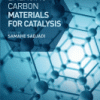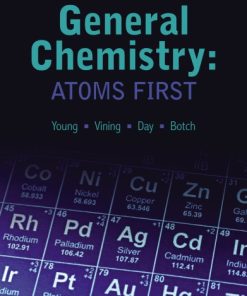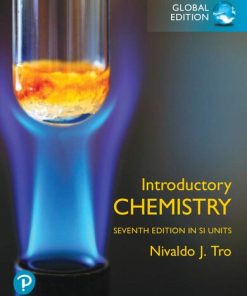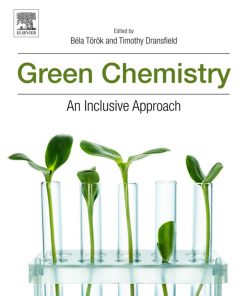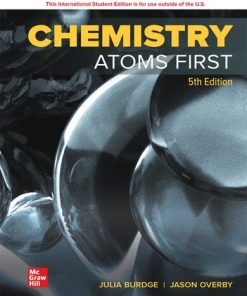(Ebook PDF) Introductory Chemistry An Atoms First Approach 1st edition by Julia Burdge 0073402702 978-0073402703 full chapters
$50.00 Original price was: $50.00.$25.00Current price is: $25.00.
Introductory Chemistry: An Atoms First Approach 1st edition by Julia Burdge – Ebook PDF Instant Download/DeliveryISBN: 0073402702, 978-0073402703
Full download Introductory Chemistry: An Atoms First Approach 1st edition after payment.

Product details:
ISBN-10 : 0073402702
ISBN-13 : 978-0073402703
Author : Julia Burdge
From its very origin, Introductory Chemistry: An Atoms First Approach by Julia Burdge and Michelle Driessen has been developed and written using an atoms‐first approach specific to introductory chemistry. It is not a pared down version of a general chemistry text, but carefully crafted with the introductory‐chemistry student in mind.
The ordering of topics facilitates the conceptual development of chemistry for the novice, rather than the historical development that has been used traditionally. Its language and style are student‐friendly and conversational; and the importance and wonder of chemistry in everyday life are emphasized at every opportunity. Continuing in the Burdge tradition, this text employs an outstanding art program, a consistent problem-solving approach, interesting applications woven throughout the chapters, and a wide range of end-of-chapter problems.
Introductory Chemistry: An Atoms First Approach 1st Table of contents:
Chapter 1 Atoms and Elements
Chapter 1 Introduction
1.1 The Study of Chemistry
Why Learn Chemistry?
The Scientific Method
1.2 Atoms First
1.3 Subatomic Particles and the Nuclear Model of the Atom
1.4 Elements and the Periodic Table
1.5 Organization of the Periodic Table
1.6 Isotopes
1.7 Atomic Mass
Chapter Summary
Key Terms
Key Skills
Organization of the Periodic Table
Key Skills Questions
Questions and Problems
Section 1.1: The Study of Chemistry
Section 1.2: Atoms First
Section 1.3: Subatomic Particles and the Nuclear Model of the Atom
Section 1.4: Elements and the Periodic Table
Section 1.5: Organization of the Periodic Table
Section 1.6: Isotopes
Section 1.7: Atomic Mass
Chapter 2 Electrons and the Periodic Table
Chapter 2 Introduction
2.1 The Nature of Light
2.2 The Bohr Atom
2.3 Atomic Orbitals
s orbitals
p orbitals
d and f orbitals
2.4 Electron Configurations
2.5 Electron Configurations and the Periodic Table
2.6 Periodic Trends
2.7 Ions: The Loss and Gain of Electrons
Electron Configuration of Ions
Lewis Dot Symbols of Ions
Chapter Summary
Key Terms
Key Skills
Determining Ground-State Valence Electron Configurations Using the Periodic Table
Key Skills Problems
Questions and Problems
Section 2.1: The Nature of Light
Section 2.2: The Bohr Atom
Section 2.3: Atomic Orbitals
Section 2.4: Electron Configurations
Section 2.5: Electron Configurations and the Periodic Table
Section 2.6: Periodic Trends
Section 2.7: Ions: The Loss and Gain of Electrons
Additional Problems
Familiar Chemistry Fireworks
Chapter 3 Compounds and Chemical Bonds
Chapter 3 Introduction
3.1 Matter: Classification and Properties
States of Matter
Mixtures
Properties of Matter
3.2 Ionic Bonding and Binary Ionic Compounds
3.3 Naming Ions and Binary Ionic Compounds
Naming Atomic Cations
Naming Atomic Anions
Naming Binary Ionic Compounds
3.4 Covalent Bonding and Molecules
Covalent Bonding
Molecules
Molecular Formulas
3.5 Naming Binary Molecular Compounds
3.6 Covalent Bonding in Ionic Species: Polyatomic Ions
3.7 Acids
3.8 Substances in Review
Distinguishing Elements and Compounds
Determining Whether a Compound Is Ionic or Molecular
Naming Compounds
Chapter Summary
Key Terms
Key Skills
Naming Compounds
Key Skills Problems
Questions and Problems
Section 3.1: Matter: Classification and Properties
Section 3.2: Ionic Bonding and Binary Ionic Compounds
Section 3.3: Naming Ions and Binary Ionic Compounds
Section 3.4: Covalent Bonding and Molecules
Section 3.5: Naming Binary Molecular Compounds
Section 3.6: Covalent Bonding in Ionic Species: Polyatomic Ions
Section 3.7: Acids
Section 3.8: Substances in Review
Chapter 4 How Chemists Use Numbers
Chapter 4 Introduction
4.1 Units of Measurement
Base Units
Mass, Length, and Time
Metric Multipliers
Temperature
4.2 Scientific Notation
Very Large Numbers
Very Small Numbers
Using the Scientific Notation Function on Your Calculator
4.3 Significant Figures
Exact Numbers
Measured Numbers
Calculations with Measured Numbers
4.4 Unit Conversion
Conversion Factors
Derived Units
Dimensional Analysis
4.5 Success in Introductory Chemistry Class
Chapter Summary
Key Terms
Key Equations
Key Skills
Dimensional Analysis
Key Skills Problems
Questions and Problems
Section 4.1: Units of Measurement
Section 4.2: Scientific Notation
Section 4.3: Significant Figures
Section 4.4: Unit Conversion
Chapter 5 The Mole and Chemical Formulas
Chapter 5 Introduction
5.1 Counting Atoms by Weighing
The Mole (The “Chemist’s Dozen”)
Molar Mass
Interconverting Mass, Moles, and Numbers of Atoms
5.2 Counting Molecules by Weighing
Calculating the Molar Mass of a Compound
Interconverting Mass, Moles, and Numbers of Molecules (or Formula Units)
Combining Multiple Conversions in a Single Calculation
5.3 Mass Percent Composition
5.4 Using Mass Percent Composition to Determine Empirical Formula
5.5 Using Empirical Formula and Molar Mass to Determine Molecular Formula
Chapter Summary
Key Terms
Key Equations
Key Skills
Molar Mass Determination and Conversion from Mass to Moles
Key Skills Problems
Questions and Problems
Section 5.1: Counting Atoms by Weighing
Section 5.2: Counting Molecules by Weighing
Section 5.3: Mass Percent Composition
Section 5.4: Using Mass Percent Composition to Determine Empirical Formula
Section 5.5: Using Empirical Formula and Molar Mass to Determine Molecular Formula
Cumulative Problems
Chapter 6 Molecular Shape
Chapter 6 Introduction
6.1 Drawing Simple Lewis Structures
Lewis Structures of Simple Molecules
Lewis Structures of Molecules with a Central Atom
Lewis Structures of Simple Polyatomic Ions
6.2 Lewis Structures Continued
Lewis Structures with Less Obvious Skeletal Structures
Lewis Structures with Multiple Bonds
Exceptions to the Octet Rule
6.3 Resonance Structures
6.4 Molecular Shape
Bond Angles
6.5 Electronegativity and Polarity
Electronegativity
Bond Polarity
Molecular Polarity
6.6 Intermolecular Forces
Dipole-Dipole Forces
Hydrogen Bonding
Dispersion Forces
Intermolecular Forces in Review
Chapter Summary
Key Terms
Key Skills
Molecular Shape and Polarity
Key Skills Problems
Questions and Problems
Section 6.1: Drawing Simple Lewis Structures
Section 6.2: Lewis Structures Continued
Section 6.3: Resonance structures
Section 6.4: Molecular Shape
Section 6.5: Electronegativity and Polarity
Section 6.6: Intermolecular Forces
Cumulative Problems
Chapter 7 Solids, Liquids, and Phase Changes
Chapter 7 Introduction
7.1 General Properties of the Condensed Phases
7.2 Types of Solids
Ionic Solids
Molecular Solids
Atomic Solids
Network Solids
7.3 Physical Properties of Solids
Vapor Pressure
Melting Point
7.4 Physical Properties of Liquids
Viscosity
Surface Tension
Vapor Pressure
Boiling Point
7.5 Energy and Physical Changes
Temperature Changes
Solid-Liquid Phase Changes: Melting and Freezing
Liquid-Gas Phase Changes: Vaporization and Condensation
Solid-Gas Phase Changes: Sublimation
Chapter Summary
Key Terms
Key Equations
Key Skills
Intermolecular Forces
Key Skills Problems
Questions and Problems
Section 7.1: General Properties of the Condensed Phases
Section 7.2: Types of Solids
Section 7.3: Physical Properties of Solids
Section 7.4: Physical Properties of Liquids
Section 7.5: Energy and Physical Changes
Chapter 8 Gases
Chapter 8 Introduction
8.1 Properties of Gases
Gaseous Substances
Kinetic Molecular Theory of Gases
8.2 Pressure
Definition and Units of Pressure
Measurement of Pressure
8.3 The Gas Equations
The Ideal Gas Equation
The Combined Gas Equation
The Molar Mass Gas Equation
8.4 The Gas Laws
Boyle’s Law: The Pressure-Volume Relationship
Charles’s Law: The Temperature-Volume Relationship
Avogadro’s Law: The Moles-Volume Relationship
8.5 Gas Mixtures
Dalton’s Law of Partial Pressures
Mole Fractions
Chapter Summary
Key Terms
Key Equations
Key Skills
Mole Fractions
Key Skills Problems
Questions and Problems
SECTION 8.1: Properties of Gases
SECTION 8.2: Pressure
SECTION 8.3: The Gas Equations
SECTION 8.4: The Gas Laws
SECTION 8.5: Gas Mixtures
Chapter 9 Physical Properties of Solutions
Chapter 9 Introduction
9.1 General Properties of Solutions
9.2 Aqueous Solubility
9.3 Solution Concentration
Percent by Mass
Molarity
Molality
Comparison of Concentration Units
9.4 Solution Composition
9.5 Solution Preparation
Preparation of a Solution from a Solid
Preparation of a More Dilute Solution from a Concentrated Solution
9.6 Colligative Properties
Freezing-Point Depression
Boiling-Point Elevation
Osmotic Pressure
Chapter Summary
Key Terms
Key Equations
Key Skills
Determination of Moles of Solute Contained Within a Solution
Key Skills Problems
Questions and Problems
Section 9.1: General Properties of Solutions
Section 9.2: Aqueous Solubility
Section 9.3: Solution Concentration
Section 9.4: Solution Composition
Section 9.5: Solution Preparation
Section 9.6: Colligative Properties
Chapter 10 Chemical Reactions and Chemical Equations
Chapter 10 Introduction
10.1 Recognizing Chemical Reactions
10.2 Representing Chemical Reactions with Chemical Equations
Metals
Nonmetals
Noble Gases
Metalloids
10.3 Balancing Chemical Equations
10.4 Types of Chemical Reactions
Precipitation Reactions
Acid-Base Reactions
Oxidation-Reduction Reactions
10.5 Chemical Reactions and Energy
10.6 Chemical Reactions in Review
Chapter Summary
Key Terms
Key Skills
Net Ionic Equations
Key Skills Problems
Questions and Problems
Section 10.1: Recognizing Chemical Reactions
Section 10.2: Representing Chemical Reactions with Chemical Equations
Section 10.3: Balancing Chemical Equations
Section 10.4: Types of Chemical Reactions
Section 10.5: Chemical Reactions and Energy
Section 10.6: Chemical Reactions in Review
People also search for Introductory Chemistry: An Atoms First Approach 1st:
nivaldo tro introductory chemistry
introductory chemistry 7th edition
introductory chemistry pdf
introductory chemistry a foundation 9th edition pdf
introductory chemistry textbook
Tags:
Introductory Chemistry,An Atoms,Approach,Julia Burdge
You may also like…
Chemistry - Chemistry - General & Miscellaneous
(EBook PDF) Chemistry 6th Edition by Julia Burdge 1264507798 9781264507795 full chapters
Chemistry - Chemistry - General & Miscellaneous
Chemistry
Science (General)
Electrons Atoms and Molecules in Inorganic Chemistry. A worked Examples Approach Joseph J. Stephanos


